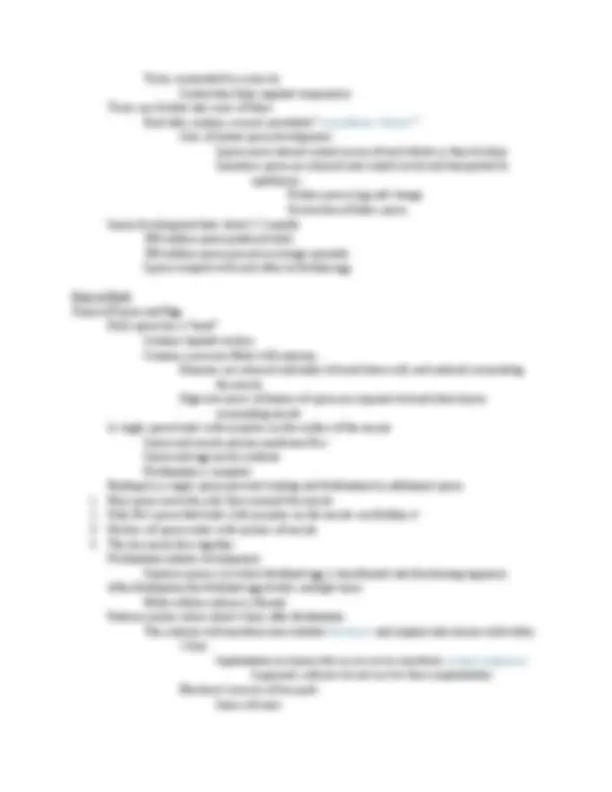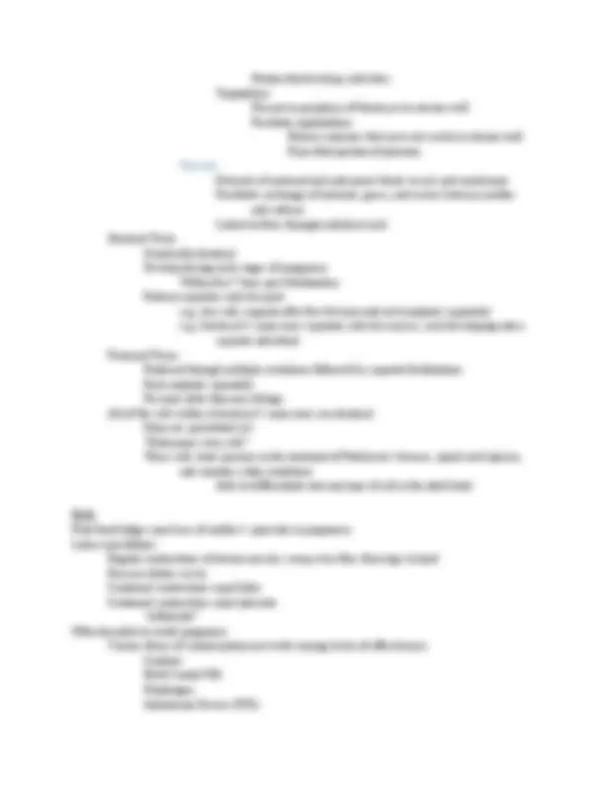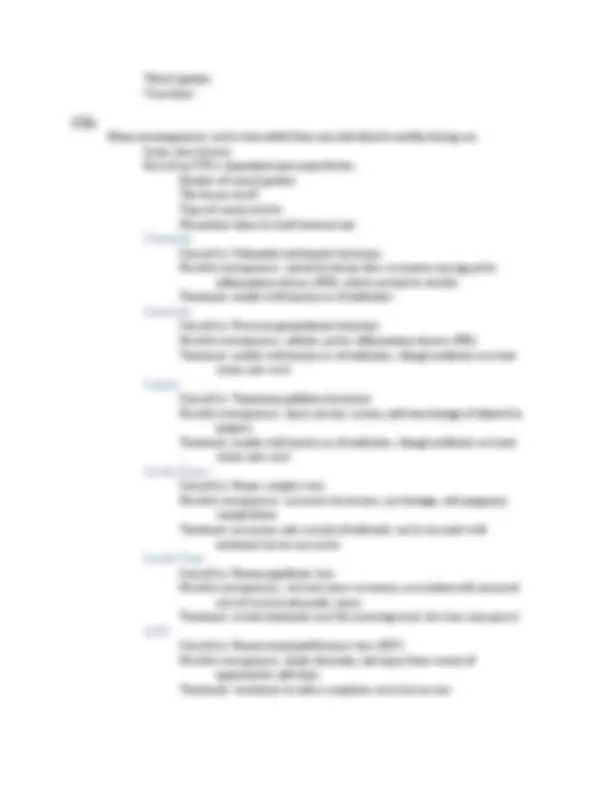





Study with the several resources on Docsity

Earn points by helping other students or get them with a premium plan


Prepare for your exams
Study with the several resources on Docsity

Earn points to download
Earn points by helping other students or get them with a premium plan
Community
Ask the community for help and clear up your study doubts
Discover the best universities in your country according to Docsity users
Free resources
Download our free guides on studying techniques, anxiety management strategies, and thesis advice from Docsity tutors
An in-depth look into the human reproductive system, focusing on the processes of ovulation, fertilization, and menstruation. It covers the development of oocytes and sperm, the roles of the male and female reproductive systems, and the consequences of sexually transmitted diseases.
Typology: Study notes
1 / 5

This page cannot be seen from the preview
Don't miss anything!




Chapter 29 – Human Reproduction Eggs in females when she is born exist in precursor forms called oocytes Lie within ovaries A pair of walnut-shaped organs within the pelvic region Oocytes are expelled approximately every 28 days “Ovulation” Travels down uterine tube (Fallopian tube) toward uterus Fertilization may occur during this journey Sperm is produced, in unfinished form, in sets of tubules in the two male testes They are transported to the epididymis, where further development occurs With sexual excitation, sperm are transported through the vas deferens to the urethra Secretions from several glands are added to the sperm to form semen Semen is ejaculated into the female vagina Human Reproduction in Outline Sperm move into the uterine tubes Relatively few of the sperm released are likely to encounter a released oocyte A sperm may fertilize an oocyte This fertilized egg divides and ultimately implants into the uterine wall Development continues while implanted into the uterine wall Birth occurs approximately 38 weeks after fertilization Mature egg is the largest cell in the human body Female Reproductive System Mammary glands, uterine tubes, ovaries, uterus, vagina, external genitalia The female reproductive system must fulfill two different roles Formation is an egg Creation of an environment in which a fertilized egg can develop An important part of the uterine environment is built with each cycle Each 28 days, on average Unless an egg is fertilized, this uterine environment is dismantled “Menstruation” cyclical release of blood and uterine tissue from the female reproductive tract This uterine tissue is the “endometrium”, which would have housed an implanted embryo Costs associated with menstruation Discomfort Loss of blood and other tissue 1.4 fluid ounces of blood & similar amount of uterine tissue lost Why does menstruation exist? Maintaining a permanent embryonic environment in uterus is more costly Inner endometrium changes form near time of ovulation Primary activity switches from growth (“proliferative” phase) to secretion of a nutrient-rich mucus (“secretory” phase)
Secretory phase endometrium is required for implantation Secretory phase endometrium cannot perpetuate itself Eggs develop from precursor cells called “oocytes” Develop in the other portion of ovary Surrounded by a collection of accessory cells (“Follicle cells”) Provide the oocyte with nutrients The oocyte and surrounding follicle cells are called “ovarian follicle” Basic unit of oocyte development Every oocyte maturing into an egg must go through certain developmental stages Begins with several follicles Some follicles develop into primary follicles Some primary follicles develop into secondary follicles A single secondary follicle develops into a tertiary follicle Nurtures an oocyte through its time in the ovary Hormonal influences cause tertiary follicle to rupture midway through menstrual cycle Oocyte is expelled Still surrounded by some accessory cells “Ovulation” Occurs once with every cycle Ovulated oocyte and accessory cells enter uterine tube Ciliated cells of the uterine tube create liquid current Current carries oocyte about four inches through uterine tube over 4 days Fertilization by sperm can occur during this time Ruptured tertiary follicle develops into “corpus luteum” Secretes hormones that help prepare female reproductive tract for pregnancy Continued secretion will maintain pregnancy If pregnancy does not occur, corpus luteum will disintegrate after about 12 days Male Reproductive System Structures of male reproductive system Sperm begin development in the BU Epididymis is site of sperm maturation and storage Sperm move through vas deferens during ejaculation Both vas deferens empty into urethra Sperm, in the form of semen, exit the body through urethra Accessory glands produce secretions that are added to sperm Seminal vesicles Prostate gland Bulbourethral glands Sperm + these secretions = semen Sperm development requires temperatures slightly cooler than rest of body Testes are external Slightly cooler environment
Portion that develops into baby Trophoblast Present on periphery of blastocyst in uterine wall Facilitate implantation Release enzymes that carve out cavity in uterine wall Form fetal portion of placenta Placenta Network of maternal and embryonic blood vessels and membranes Facilitates exchange of nutrients, gases, and wastes between mother and embryo Linked to fetus through umbilical cord Identical Twins Genetically identical Develop during early stages of pregnancy Within first 7 days post-fertilization Embryo separates into two parts e.g., two cells separate after first division and each implants separately e.g., blastocyst’s inner mass separates into two masses, each developing into a separate individual Fraternal Twins Produced through multiple ovulations followed by separate fertilizations Each implants separately No more alike than any siblings All of the cells within a blastocyst’s inner mass are identical None are specialized yet “Embryonic stem cells” These cells show promise in the treatment of Parkinson’s disease, spinal cord injuries, and countless other conditions Able to differentiate into any type of cell in the adult body Birth Fetal head lodges near base of mother’s spine late in pregnancy Labor soon follows Regular contractions of uterine muscles sweep over fetus from legs to head Pressure dilates cervix Continued contractions expel baby Continued contractions expel placenta “Afterbirth” Often desirable to avoid pregnancy Various forms of contraception exist with varying levels of effectiveness Condom Birth Control Pill Diaphragm Intrauterine Device (IUD)
Tubal Ligation Vasectomy STDs Many microorganisms can be transmitted from one individual to another during sex Some cause disease Risk of an STD is dependant upon many factors Number of sexual partners The disease itself Type of sexual activity Precautions taken to avoid transmission Chlamydia Caused by: Chlamydia trachomatis bacterium Possible consequences: spread to uterine tubes in women causing pelvic inflammatory disease (PID), which can lead to sterility Treatment: curable with timely use of antibiotics Gonorrhea Caused by: Neisseria gonnorhoeae bacterium Possible consequences: arthritis, pelvic inflammatory disease (PID) Treatment: curable with timely use of antibiotics, though antibiotic-resistant strains now exist Syphilis Caused by: Treponema pallidum bacterium Possible consequences: heart, nervous system, and bone damage if allowed to progress Treatment: curable with timely use of antibiotics, though antibiotic-resistant strains now exist Genital Herpes Caused by: Herpes simplex virus Possible consequences: recurrent skin lesions, eye damage, and pregnancy complications Treatment: occurrence and severity of outbreaks can be lessened with treatment, but no cure exists Genital Warts Caused by: Human papilloma virus Possible consequences: cervical cancer in women, association with increased risk of cervical and penile cancer Treatment: several treatments exist for removing warts, but virus may persist AIDS Caused by: Human immunodeficiency virus (HIV) Possible consequences: death, dementia, and injury from variety of opportunistic infections Treatments: treatments to reduce symptoms exist, but no cure